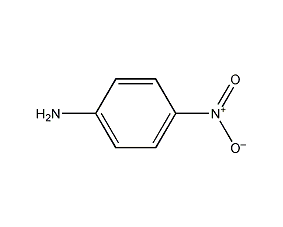
Structural formula
| Business number | 02H0 |
|---|---|
| Molecular formula | C6H6N2O2 |
| Molecular weight | 138.13 |
| label |
p-Nitroaniline, 4-nitroaniline, 1-amino-4-nitrobenzene, Ice dye diazo component 37, p-nitroaniline, p-nitroaniline, p-nitroaniline, Kitronnilin, 4-Aminonitrobenzene, 4-Nitraniline, 4-nitro-anilin, 4-Nitro-benzenamin, Aromatic nitrogen-containing compounds and their derivatives |
Numbering system
CAS number:100-01-6
MDL number:MFCD00007858
EINECS number:202-810-1
RTECS number:BY7000000
BRN number:508690
PubChem number:24897555
Physical property data
1. Appearance: yellow crystal or powder [1]
2. Melting point (℃): 146~148[2]
3. Boiling point (℃): 332[3]
4. Relative density (water=1): 1.42[4]
5. Relative vapor density (air=1): 4.77[5]
6. Saturated vapor pressure (kPa): 0.13 (142.4℃ )[6]
7. Heat of combustion (kJ/mol): -3191.0[7]
8. Critical Pressure (MPa): 4.42[8]
9. Octanol/water partition coefficient: 1.39[9]
10. Flash point (℃): 199 (CC) [10]
11. Ignition temperature (℃): 180[11]
12. Explosion upper limit (%): 9.8[12]
13. Explosion lower limit (%): 1.5[13]
14. Solubility: Insoluble in water, slightly soluble in benzene, soluble in ethanol, ether, acetone, and methanol. [14]
Toxicological data
1. Acute toxicity[15] LD50: 750mg/kg (rat oral)
2. Irritation No data yet
3. Subacute and chronic toxicity [16] Long-term and large-scale exposure can cause liver damage.
4. Mutagenicity [17] Microbial mutagenicity: Salmonella typhimurium 333μg/dish. DNA repair: Bacillus subtilis 5mg/dish. Cytogenetic analysis: Hamster ovary 173mg/L. Sister chromatid exchange: Hamster ovary 1600mg/L.
Ecological data
1. Ecotoxicity[18]
LC50: 161mg/L (24h), 106mg/L (96h) (blackhead soft mouth Minnow); 35mg/L (48h) (Tall-bodied yarrow); 87.6mg/L (96h) (zebrafish)
EC50: 24~25mg/L (24h) (Daphnia); 9.7~10.4mg/L (60h) (Tetrahymena pyriformis)
2. Biodegradability No data yet
3. Non-biodegradability No data
Molecular structure data
1. Molar refractive index: 37.03
2. Molar volume (cm3/mol): 103.5
3. Isotonic specific volume (90.2K ): 288.5
4. Surface tension (dyne/cm): 60.3
5. Dielectric constant:
6. Dipole moment (10-24cm3):
7. Polarizability: 14.68
Compute chemical data
1. Reference value for hydrophobic parameter calculation (XlogP): None
2. Number of hydrogen bond donors: 1
3. Number of hydrogen bond acceptors: 3
4. Number of rotatable chemical bonds: 0
5. Number of tautomers: none
6. Topological molecule polar surface area 71.8
7. Number of heavy atoms: 10
8. Surface charge: 0
9. Complexity: 124
10. Number of isotope atoms: 0
11. Determine the number of atomic stereocenters: 0
12. Uncertain number of atomic stereocenters: 0
13. Determine the number of chemical bond stereocenters: 0
14. Number of uncertain chemical bond stereocenters: 0
15. Number of covalent bond units: 1
Properties and stability
1. This product is highly toxic. Can cause more severe blood poisoning than aniline. This effect is stronger if organic solvents are also present or after drinking alcohol. Acute poisoning manifests as headache, facial flushing, and shortness of breath, sometimes accompanied by nausea and vomiting, followed by muscle weakness, cyanosis, weak pulse, and shortness of breath. Skin contact can cause eczema and dermatitis.
2. Stability[19] Stable
3. Incompatible substances[20] Strong oxidants, strong acids, acid chlorides, acid anhydrides, chloroform
4. Conditions to avoid contact [21] Heating
5. Polymerization hazard[22] No polymerization
6. Decomposition products[23] Nitrogen oxides, ammonia
Storage method
1. Storage precautions [24] Store in a cool, ventilated warehouse. Keep away from fire and heat sources. The packaging is sealed. They should be stored separately from oxidants, acids, and food chemicals, and avoid mixed storage. Equipped with the appropriate variety and quantity of fire equipment. Suitable materials should be available in the storage area to contain spills.
2. During operation, the production site should be well ventilated, the equipment should be sealed, individuals should wear protective equipment, and physical examinations should be carried out regularly, including blood, nervous system and urine tests. Patients with acute poisoning should leave the scene immediately, pay attention to keeping the patient warm, and inject methylene blue solution intravenously. The maximum allowable concentration in the air is 0.1mg/m3.
3. Packed in plastic bags lined with fiberboard drums or iron drums, each drum can be 30kg, 35kg, 40kg, 45kg or 50kg. During storage and transportation, prevent exposure to the sun, rain, crushing, and damage. Store in a dry, ventilated place. Store and transport according to regulations for highly toxic organic compounds.
Synthesis method
Industrial production of p-nitroaniline. The methods of nitration and hydrolysis of acetanilide can be used, and the method of ammonialysis of p-nitrochlorophenyl can also be used.
1. It is made from acetanilide as raw material through nitration and hydrolysis. Raw material consumption quota: acetanilide 1210kg/t, nitric acid (90%) 580kg/t, sulfuric acid 3620kg/t, liquid alkali (30%) 660kg/t.
![]()
2. Use p-nitrochloride Benzene is used as raw material and can be produced by the autoclave intermittent method or the pipeline reactor for continuous production, with the yield being around 94%. Raw material consumption quota: p-nitrochlorobenzene (97%) 1170kg/t, ammonia water (28%) 700kg/t.

3. First, add water to the industrial product p-nitroaniline and steam to remove the isomers, and then recrystallize it with ethanol.
Purpose
1. Used as intermediates for dyes and antioxidants, corrosion inhibitors, and analytical reagents.
2. Used as analytical reagents and dye intermediates. Mainly used as ice dye dye color base scarlet GG color base. It is also an intermediate for direct dyes, acid dyes, disperse dyes and neutral dyes. It can be used to make black salt K, for dyeing and printing cotton and linen fabrics; but it is mainly an azo dye intermediate, such as used to make direct dark green B, direct light-fast black G, acid medium brown G, acid black 10B, Disperse Orange 2RL, Disperse Orange S-4RL, Disperse Red SE-R, Disperse Yellow Brown S-3GL, Leather Black DMX, Fur Black D and Direct Gray D, etc.
3. Used as an intermediate in the synthesis of pesticides and veterinary drugs.
4. Used as intermediates for dyes and antioxidants, corrosion inhibitors, and analytical reagents. [25]


